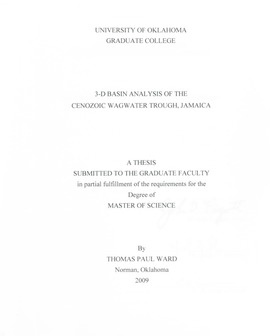| dc.contributor.author | Ward, Thomas Paul | |
| dc.date.accessioned | 2017-02-20T23:39:41Z | |
| dc.date.available | 2017-02-20T23:39:41Z | |
| dc.date.issued | 2009 | |
| dc.identifier.uri | https://hdl.handle.net/11244/48339 | |
| dc.description.abstract | The Wagwater trough in eastern Jamaica is a fault-bounded half graben that formed as a result of regional dextral shear at a releasing bend connecting the Septentiornal-Oriente-Swan-Motagua and Plantain Garden-Swan fault systems. There are two major stage of tectonic development: (1) Paleocene to Middle Eocene fault mechanical crustal subsidence (66-51 Ma; _=1.66), (2) Middle Eocene to Middle Miocene thermal subsidence (51-10 Ma), and (3) Middle Miocene to Holocene crustal shortening (10-0 Ma; _=0.81). Clastic sedimentation prevailed during the period of fault mechanical crustal subsidence with the deposition of the Wagwater Formation and Richmond Formation, while the period of thermal subsidence was period with carbonate deposition of the Yellow Limestone and White Limestone Groups. Early-rifting commenced with the sedimentation of Wagwater alluvium. A marine transgression allowed the deposition of Richmond shelf and slope deposits and later Yellow and White Limestone deposits. Middle Miocene marks a period of time when regional dextral shear was reversed. The Wagwater Trough experienced negative tectonic subsidence caused by regional sinistral shear at a constraining bend. This caused crustal shortening and surface exposure of the sediments of the Wagwater Trough. By constraining the present-day depth to basement using the Bouguer gravity anomaly, basin subsidence produced sediment thicknesses up to 6,000 meters. | |
| dc.description.abstract | Two end-member rifting heat flow model likely bracket and constrain the heat flow of the basin: (1) calculated from a pre ent-day heat flow of 0.96 H.F.U. and (2) calculated from a present-day heat flow of 1.4 H.F.U. Both modeled thermal conditions allow for the shale layer of the Richmond Formation to range from mature enough to be in the early oil and mid oil windows for the 0.96 H.F.U. model to middle and late oil windows and gas window for the 1.4 H.F.U. model. The first in situ oil for the rifting 1.4 H.F.U. model commenced at 52 Ma, while that for the rifting 0.96 H.F.U. model is 49 Ma. First expulsion time was 50 Ma for rifting 1.4 H.F.U. model and was 41 Ma for the rifting 0.96 H.F.U. case. Hydrocarbons could potentially accumulate in traps based on two cases: the impermeable fault model and the permeable fault model. | |
| dc.language | en_US | |
| dc.subject | Geology--Jamaica | |
| dc.subject | Petroleum--Geology--Jamaica | |
| dc.subject | Seismic reflection method | |
| dc.subject | Geophysics--Jamaica | |
| dc.title | 3-D Basin Analysis Of The Cenozoic Wagwater Trough, Jamaica | |
| dc.type | Thesis | |
| dc.date.manuscript | 2009 | |
| dc.thesis.degree | Master of Science | |
| ou.group | Conoco Phillips School of Geology and Geophysics | |
